Physical Address
304 North Cardinal St.
Dorchester Center, MA 02124
You may not see it, but it sees you . Jack Hughston, MD, discussing the physical examination
The foot, ankle, and leg are parts of the body that are readily accessible to careful physical examination. In the vast majority of cases, a definitive diagnosis can be reached by obtaining a careful history, conducting a proper physical examination, and using the indicated ancillary diagnostic procedures. Effective examination of the lower extremity can be dependent on the patient's age and receptiveness to examination.
In this chapter, the focus is on examination of the fully developed foot and ankle. The reader will receive a framework for a systematic approach to the physical examination. This will give a background for understanding the pathology described in subsequent chapters. In addition, a detailed description of the topographic anatomy of the foot and ankle is provided. It is with this knowledge that the practitioner can best evaluate the abnormalities in this easily palpable body part. It must be stressed that one sees only what one is looking for, or, in the words of a wise Southern gentleman physician “you may not see it [foot pathology], but it sees you.” Keep your eyes wide open.
To prevent overlooking pertinent findings, the examiner should follow a rigorous routine. The particular routine adopted will vary depending on personal preference and arrangement of office facilities. The suggestion is to consciously formulate this routine and school oneself to deviate rarely from it. This will best ensure nothing is missed. However, no matter what procedure is used, the examiner must consider the foot and ankle from three different points of view.
First, the foot and ankle should be seen systemically or as part of the greater body. In the detailed examination, the effects of systemic problems cannot be underestimated. The foot examination can reveal the presence of systemic disease as well as give evidence of circulatory, neuropathic, metabolic, and cutaneous abnormalities. The examiner should not be so focused on the foot as to miss a much more illustrative and often treatable global disease.
Second, the foot and ankle should be considered an important component of the locomotor system. They play reciprocal roles with the suprapedal segments, and abnormal function of any part of the locomotor apparatus is reflected in adaptive changes in the normal parts. Therefore it is helpful for the examiner to observe the patient walking over an appreciable distance.
Third, the human foot and ankle should be viewed as relatively recent evolutionary acquisitions; thus, they are subject to considerable individual anatomic and functional variation. It is regrettable that in most of the anatomic and orthopaedic literature, only average values for the positions of axes of the major articulations and for ranges of motion about these axes are given (see Chapter 1 ). It so happens that an average person is difficult to find, particularly among patients seeking help in our offices. The examiner should be aware of these variations and should also be cognizant of their functional implications. In most patients, the luxury of a “normal” contralateral extremity allows the examiner the most definitive pertinent comparison. Only with such knowledge and insight can the examiner determine the proper therapeutic course and realistically evaluate the chances of success or failure of that choice.
When examining the foot and ankle, the examiner should follow as closely as possible the procedural sequence taught in courses in introductory physical diagnosis. After taking an adequate history, the examiner first inspects, then palpates, and finally (in an orthopaedic examination) manipulates. This sequence must be modified and repeated several times as the patient performs tasks in various positions and under various stresses.
The following outline for the examination of the foot and ankle has proved useful. In subsequent sections, the authors detail specific portions of the particular examination that should be stressed.
It is helpful for the patients to be in shorts, skirts, or loose-fitting trousers to allow easy observation of the legs and knees. In general, all socks or hose are removed. The examination area should allow gait and stance observation from front and rear.
The usual sequence of examination begins with the standing examination, which is done from front and rear, and must include visualization of the knee and its alignment. The bulk of the examination is done with the patient sitting on a table slightly above the examiner. This allows for easy inspection, palpation, and manipulation of both extremities. Examination with the patient prone or supine is optional and is done as the findings of the history and examination dictate. Finally, gait is evaluated if clinically relevant. The amount of time spent on each portion of this examination sequence depends on the patient's presentation.
The importance of topographic anatomy to the examination of the foot and ankle cannot be overstated. The experienced examiner can palpate the vast majority of the pathologic structures and use radiographic tests for confirmation only. The authors divide this discussion into anatomic regions, with the palpable bones, joints, nerves and vascular structures, and ligaments and tendons highlighted.
The examination of the osteology of the lateral ankle begins with the easily palpable tip of the fibula ( Fig. 2-1 ). From the tip, the distal fibula (A) and the shaft (B) can be felt in its entirety by running the examiner's fingers proximally. The lateral gutter of the ankle joint (C) can be found by running the thumb medially over the anterior and medial edge of the fibula. The lateral shoulder of the talus can be felt at the joint line by dorsiflexing and plantar flexing the ankle. The distal syndesmosis (D) is felt by following the medial edge of the fibula superior to the joint line. The lateral wall of the calcaneus (E) can be palpated with little difficulty inferior and posterior to the tip of the fibula. If this lateral wall is palpated distal and inferior to the tip of the fibula, the peroneal tubercle (F) can be felt as the calcaneal neck nears the calcaneocuboid joint. The sinus tarsi (G) (the space in front of the posterior facet of the subtalar joint) is a palpable soft spot approximately 1 cm distal and 1 cm inferior to the tip of the fibula. The anterior portion of the posterior facet of the subtalar joint can be located with deep thumb palpation into the sinus tarsi. The lateral talar process (H) is palpated on the posterior wall of the sinus tarsi. The anterior process of the calcaneus is the anterior wall of the sinus tarsi.
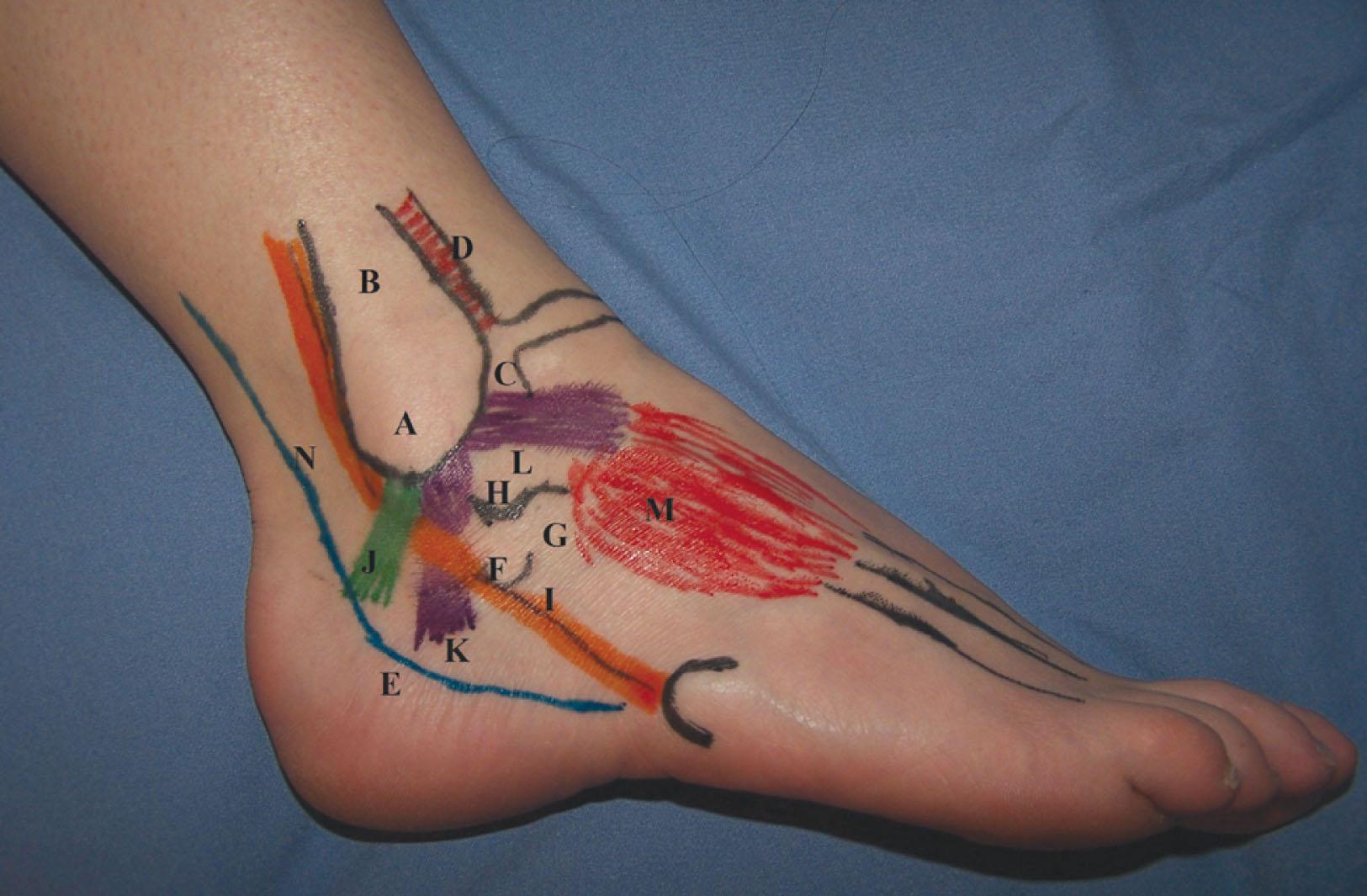
The palpable tendons, muscles, and ligaments in the lateral ankle and hindfoot can best be referenced from the tip of the fibula. Superior and posterior to the tip of the fibula are the peroneal tendons (I) . The peroneus brevis is deep to the peroneus longus. The tendons can be felt in the groove, and the anterior edge of the fibular groove is sharp and is the insertion point of the superior peroneal retinaculum (J) . Inferior and extending posterior and inferior is the calcaneofibular ligament (K) . It passes deep to the peroneal tendons as the tendons clear the fibula. From the tip of the fibula, if the examiner runs a finger 1 to 1.5 cm along the anterior edge, the anterior talofibular ligament (L) can be felt. In the uninjured patient, it can be felt as a soft tissue thickening that can be rolled against the anterior lateral talar shoulder.
If the examiner continues to run a finger superior on the anterior fibula up to the junction with the distal tibiofibular connection, the most inferior fibers of the syndesmotic ligament (D) can be felt (anterior inferior tibiofibular ligament [AITFL]). The remainder of the anterior syndesmotic ligament can be felt by palpating directly superior to the tibia and fibula junction. To truly assess this portion of the syndesmosis requires deep palpation. The extensor digitorum brevis muscle (M) can be located by palpating the sinus tarsi (G) because this muscle covers this space. The peroneal tendons can be felt on the lateral calcaneal wall, extending from the distal end of the fibular groove, which runs inferior then distal. The brevis is dorsal as the tendons turn distal. The peroneus brevis is also dorsal at the peroneal tubercle, and the peroneus longus is plantar. In this area, the tendons can be felt in their separate sheaths created by the inferior peroneal retinaculum and the tubercle.
The nervous topography in this region is fairly straightforward. The sural nerve can be felt in the fatty soft spot directly posterior to the peroneal tendons running in the fibular groove ( Fig. 2-2 ). In a thin patient, this nerve can be rolled under a finger, just posterior to the course of the peroneal tendons as the tendons enter the lateral midfoot. The superficial peroneal nerve (SPN) can first be palpated as a number of branches just superior to the distal ankle syndesmosis. Again, it is best seen and palpated by rolling the branch under a finger as the ankle is plantar flexed and inverted. Plantar flexing the fourth toe can accentuate the intermediate dorsal cutaneous branch that crosses the ankle anterolaterally ( Fig. 2-3 ). This maneuver is important to perform prior to establishing the anterolateral portal during ankle arthroscopy.
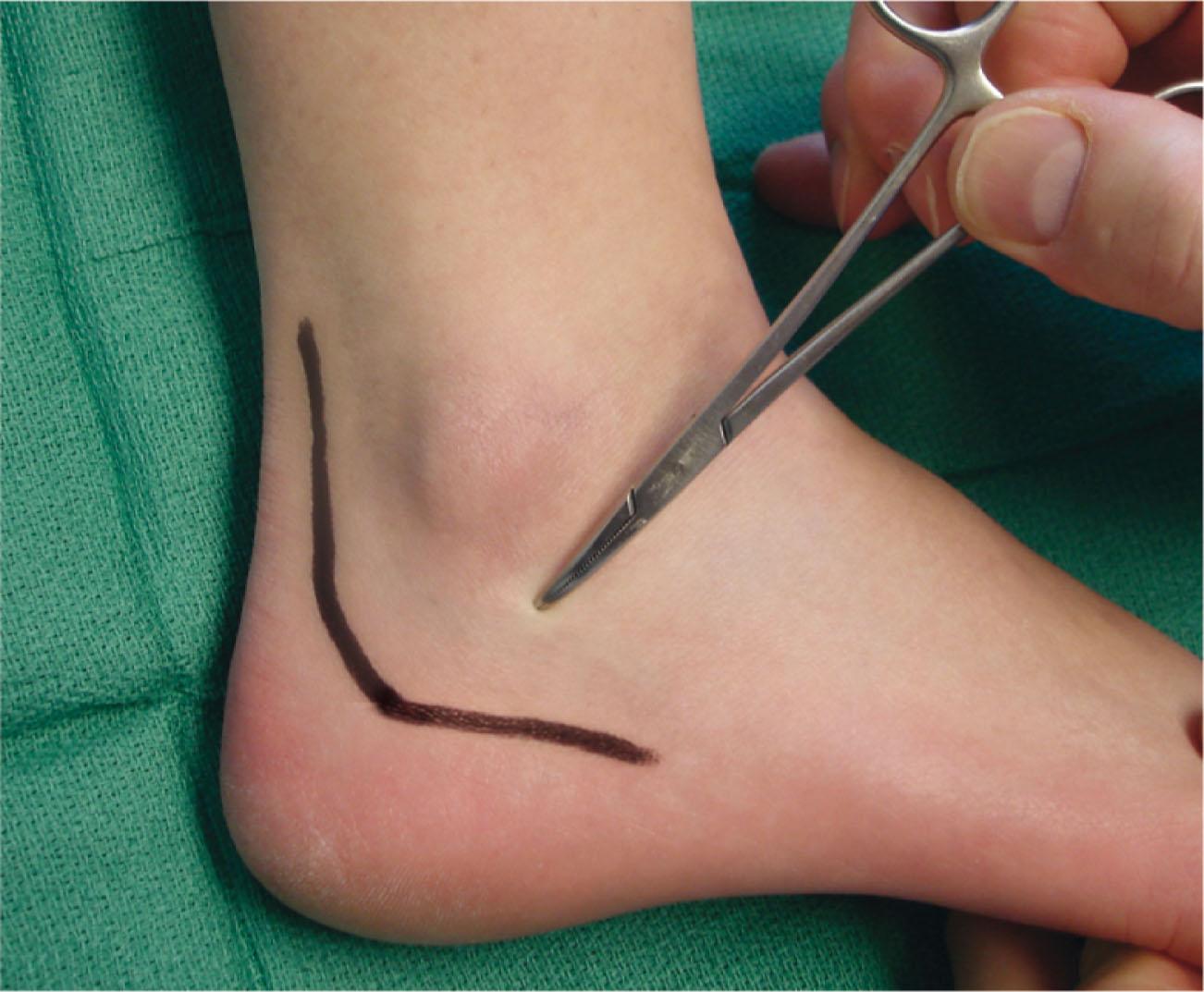
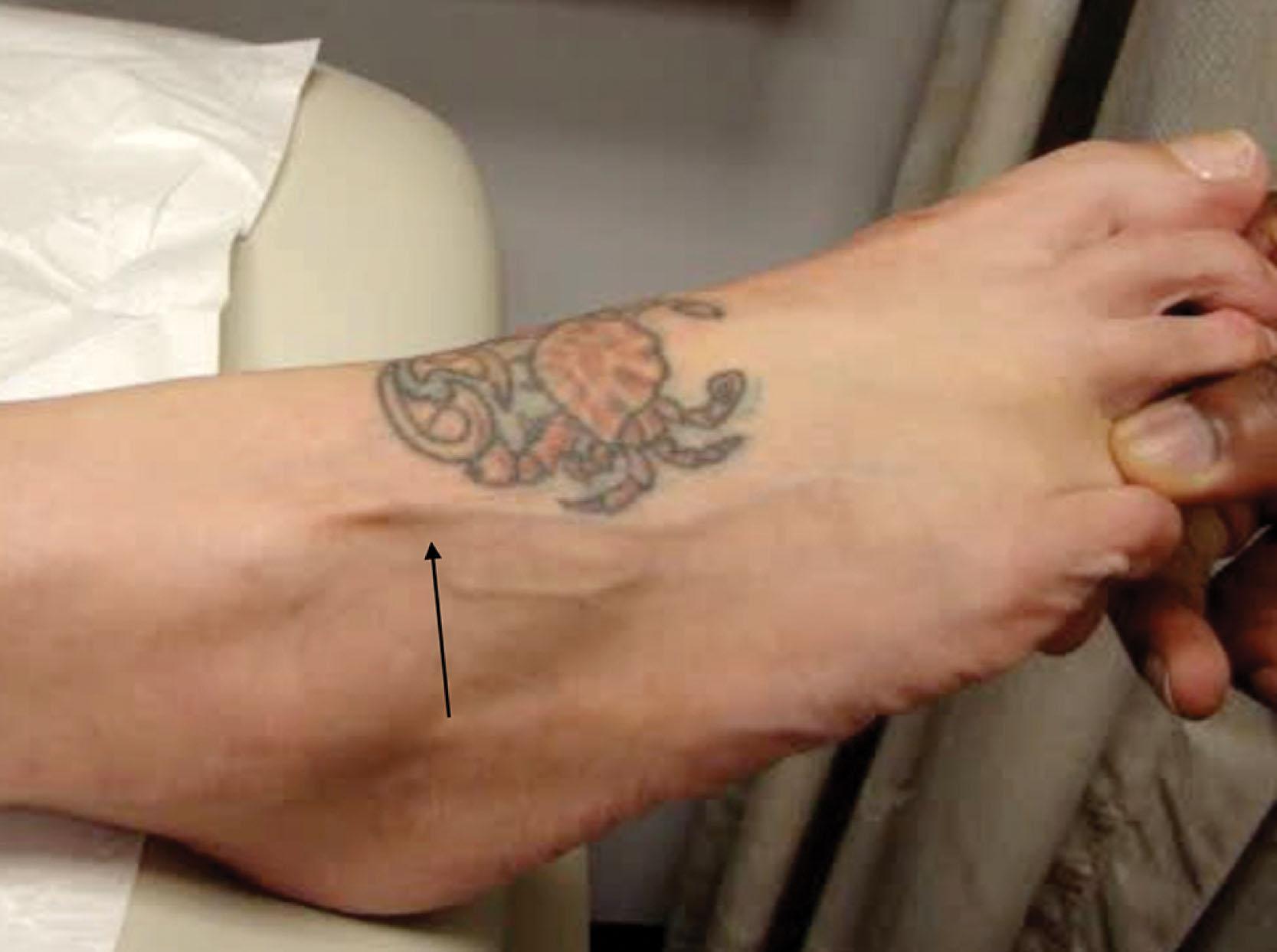
The topography of the medial ankle and hindfoot ( Fig. 2-4 ) is as accessible as the lateral. The reference point here is the tip of the medial malleolus (A) , which also allows a reference for medial ankle osteology. The tip of the malleolus is the most distal bony prominence palpated on the medial tibia. From this point, the anterior medial tibiotalar joint line (B) can be located by sliding a thumb 2 cm superior and then lateral until the thumb feels a soft spot. This is the medial gutter, the articular space between the medial malleolus and the medial talar body. Following the gutter proximally allows palpation of the anterior distal tibial plafond. This can be followed laterally across the joint. Following the malleolus posteriorly and proximally allows palpation of the entire posterior medial edge of the malleolus and tibia.
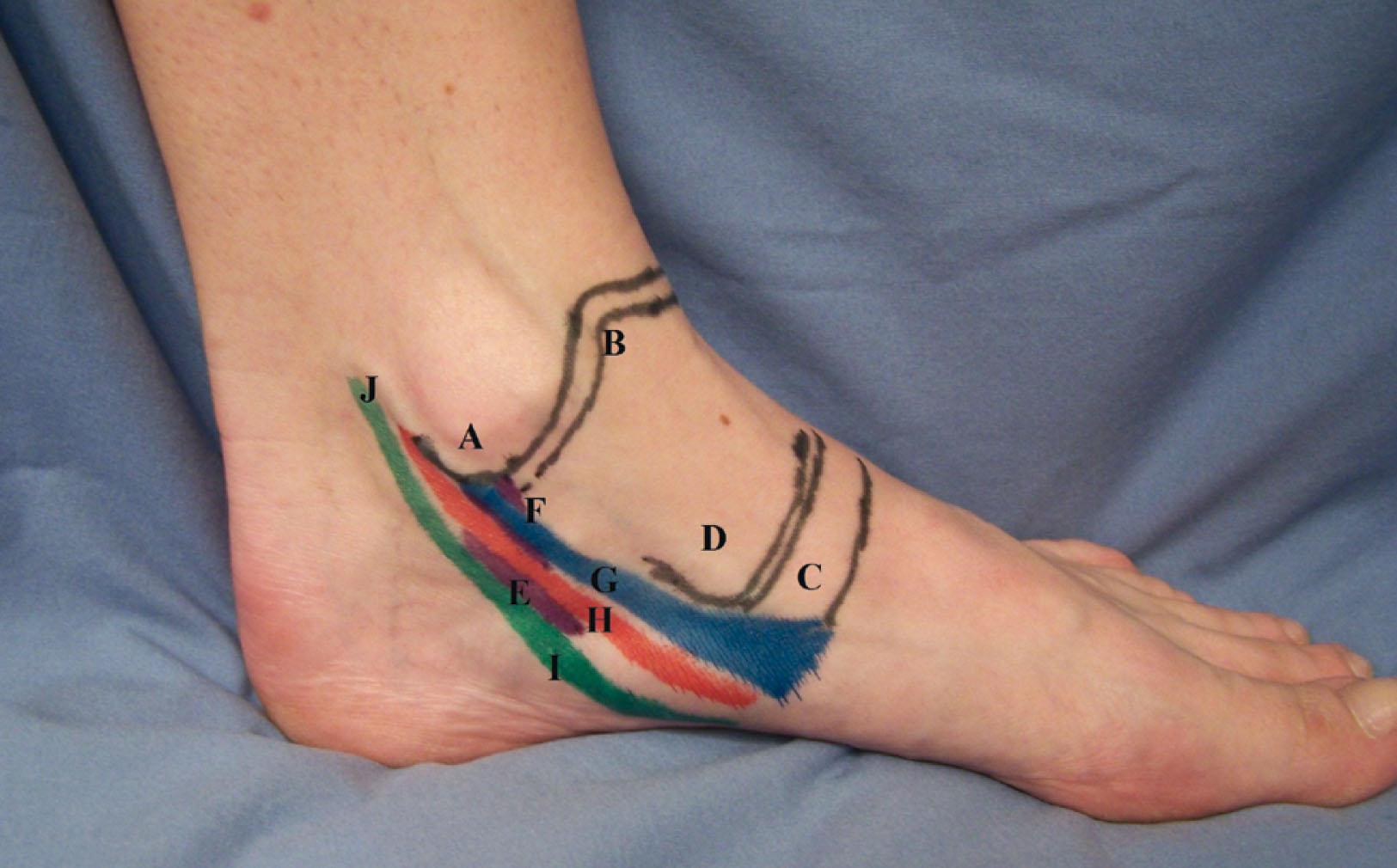
From the tip of the medial malleolus, with the ankle at neutral, a line drawn distal and slightly plantar will run through the navicular bone (C) . The navicular is best felt with the hindfoot slightly supinated. With the hindfoot pronated and the midfoot abducted, the talar head (D) can be felt on the medial foot just proximal to the navicular. The medial talonavicular joint can be delineated by adducting and abducting the transverse tarsal joint. If the line between the navicular and the medial malleolus is divided in half and drops plantarward 1 to 1.5 cm, the sustentaculum tali (E ) —the middle facet portion of the calcaneus that extends medially—can be palpated.
The palpable tendons and ligaments of the medial hindfoot can also be referenced from the tip of the medial malleolus. The superficial deltoid ligament (F) fans out from the malleolus but can best be palpated anterior and distal to it. The anterior fascicles of the deltoid can be felt by following the anterior edge of the malleolus only 1 cm. If the examiner feels the medial gutter, the origin of the superficial deltoid has been passed. The most anterior fascicles of the superficial deltoid (tibionavicular and tibiospring) can be palpated because they originate from the anterior ridge of the malleolus. The portion of the superficial deltoid originating from the tip of the malleolus can be located as it courses deep to the tendons of the medial ankle. The more posterior aspects of the superficial deltoid cannot be palpated directly, nor can the individual fascicles of the deep deltoid ligament.
The posterior tibial tendon (G) can be appreciated along its entire course. It begins at the musculotendinous junction, 5 to 7 cm from the tip of the medial malleolus, just off the posterior bony margin of the distal tibia, and travels distally, almost adherent to the posterior aspect of the medial malleolus. The tendon curves around the medial malleolus and then extends distally to the plantar medial insertion on the navicular ( Fig. 2-5 ).
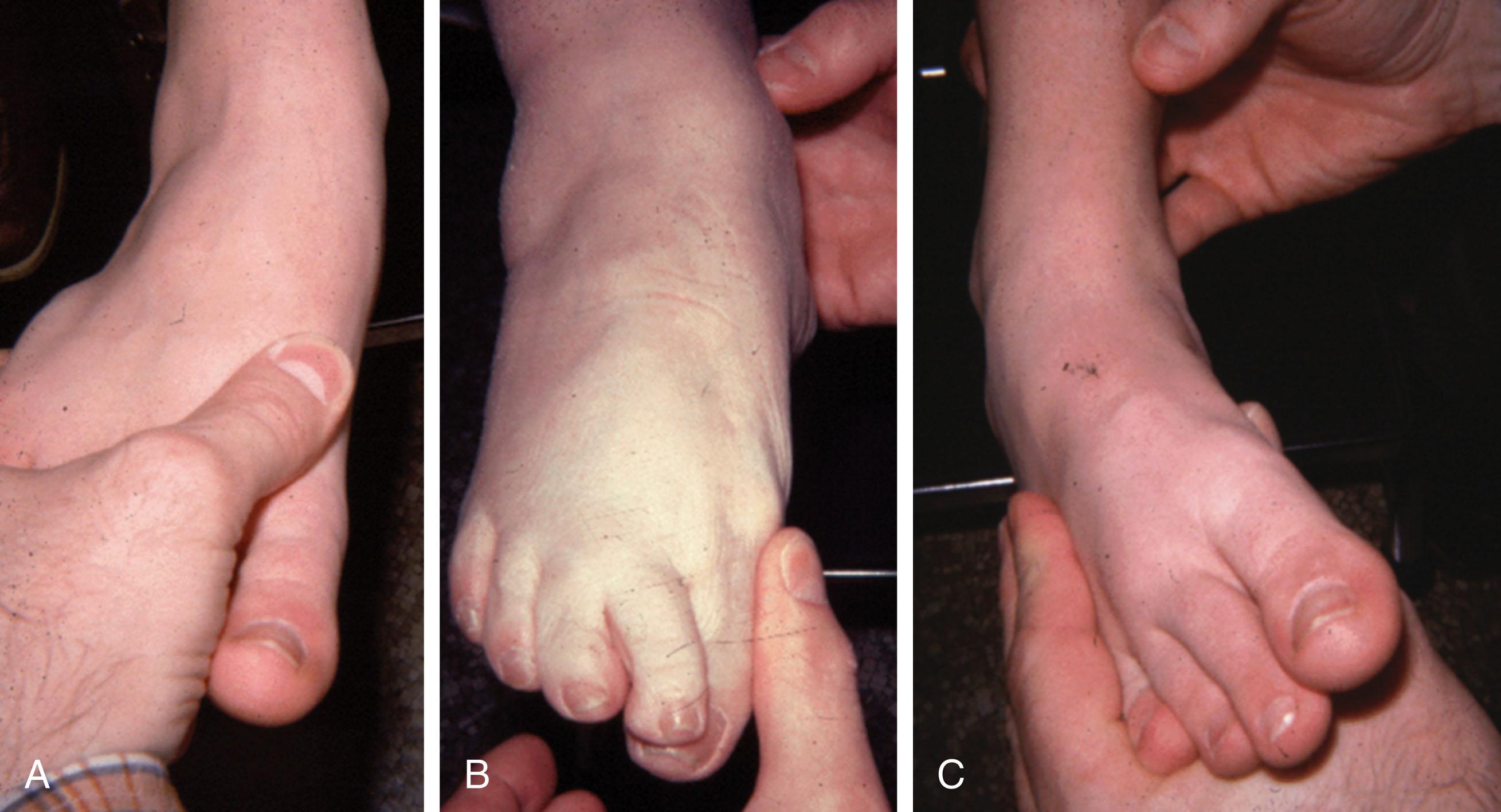
The flexor digitorum longus (FDL) (H) is easily palpated posterior and medial to the posterior tibialis tendon at the level 1 to 2 cm from the tip of the malleolus. It can be felt again in the midfoot as it crosses deep to the flexor hallucis longus (FHL) tendon. The FHL tendon (I) is best palpated in the ankle slightly posterior and deep to the posterior tibial artery and nerve at the level 1 to 2 cm proximal to the medial malleolus. The FHL also can be felt as it passes plantar to the sustentaculum tali. The superomedial aspect of the spring ligament (superomedial calcaneonavicular ligament) is palpated plantar and deep to the posterior tibial tendon, just proximal to the tendon's insertion on the plantar-medial navicular.
It is important to locate the neurovascular structures of the medial ankle. The pulse of the posterior tibial artery (see label J in Fig. 2-4 ) can be felt 1 to 2 cm posterior and medial to the medial edge of the medial malleolus. The pulse is strongest approximately 2 cm posterior to the malleolar tip ( Fig. 2-6 ). The tibial nerve runs with the artery in the tarsal tunnel. The nerve bifurcates into the medial and lateral plantar nerves at the level of the tip of the malleolus. The medial branch courses distally and plantarly and can be palpated as it runs under the abductor hallucis muscle at the level of the medial gutter of the ankle joint ( Fig. 2-7 ). The lateral plantar nerve travels straight inferior from the tarsal tunnel and can be palpated as it runs deep to the abductor hallucis. The saphenous nerve can sometimes be palpated on the medial malleolus by rolling it gently under the fingers.
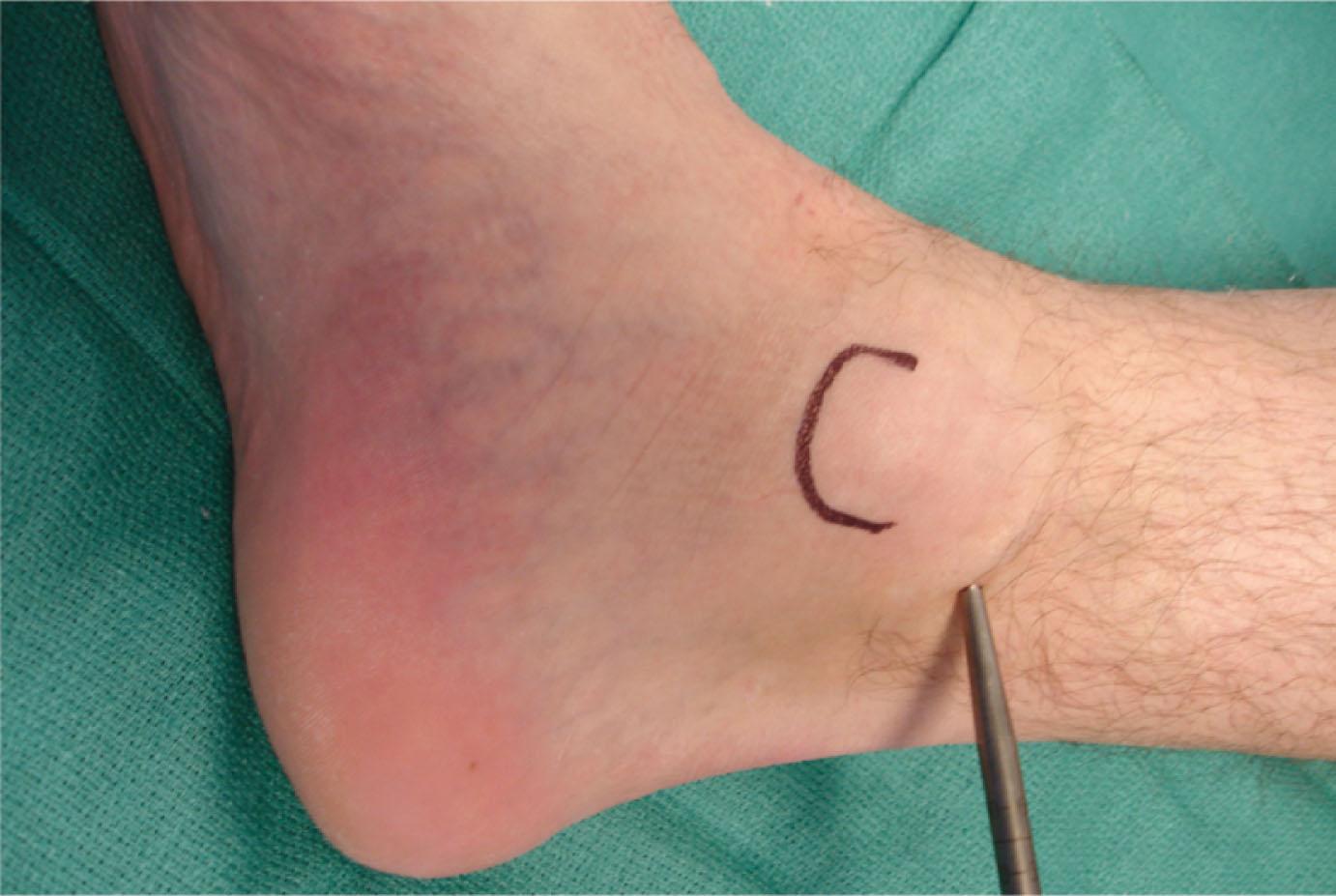
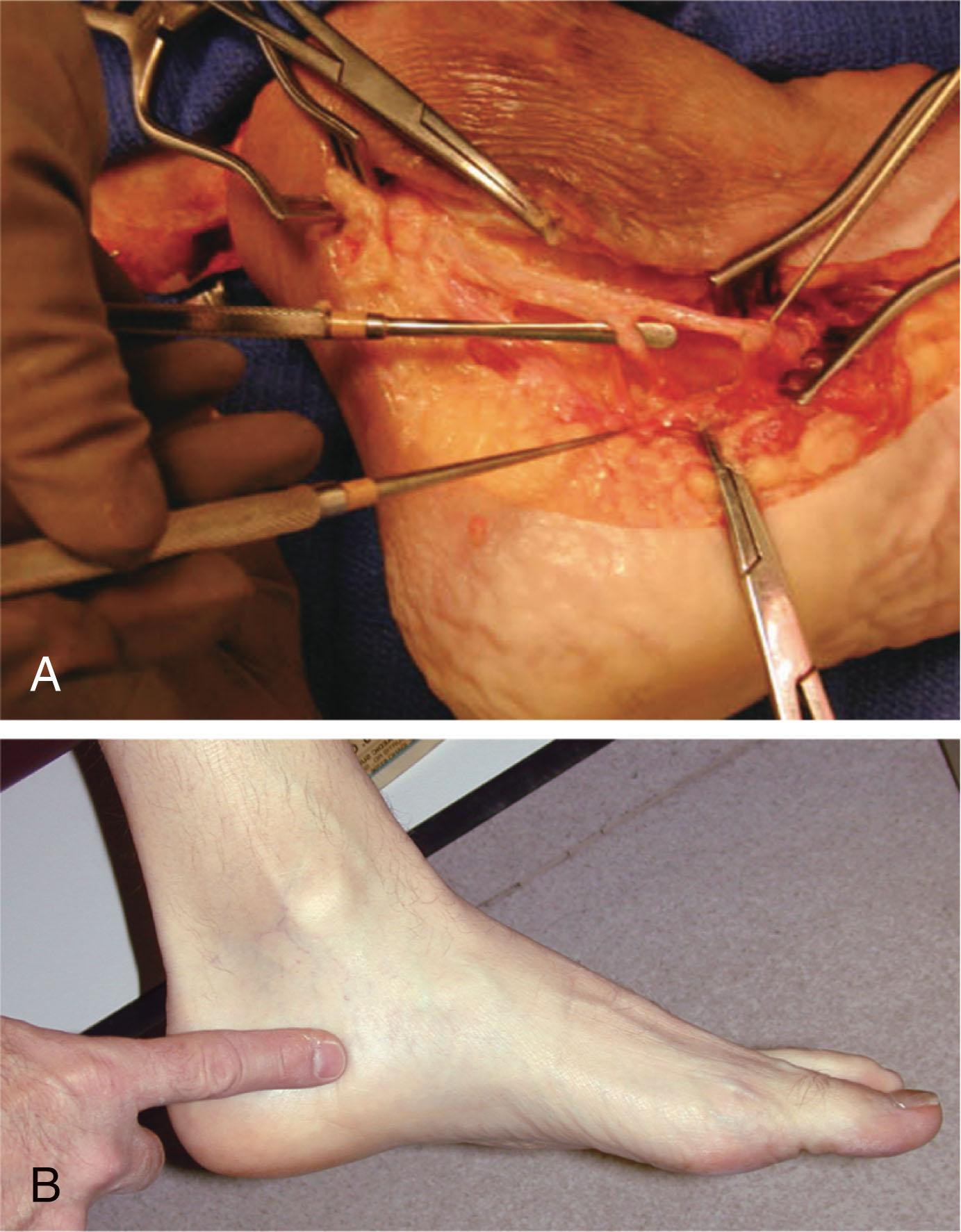
The Achilles tendon ( Fig. 2-8A ) defines the posterior ankle and hindfoot. This large tendon can best be examined with the patient prone. The tendon transects the posterior ankle and can be easily palpated because of the tendon's subcutaneous course. The tendon inserts into the calcaneus broadly, and the Achilles insertional ridge of the calcaneus (B) is palpated at the distal insertion of the tendon. The posterior calcaneus is palpated medially, laterally, and posteriorly. The retrocalcaneal space (C) , which is deep to the Achilles at its insertion, can be easily pinched by pressure from either medial or lateral. The space or its bursa (or both) is an area that is easily delineated from the Achilles proper. The posterior lateral ankle is another access point for the peroneal tendons (D) as they pass posterior to the fibula and can be an easier way to feel both tendons in the fibular groove. The same can be said for the FHL tendon (E) , which is a posteromedial ankle tendon at this point ( Fig. 2-9 ). The posterior ankle and subtalar joint can be felt with deep palpation medial or lateral to the Achilles tendon superior to the calcaneal tuberosity.
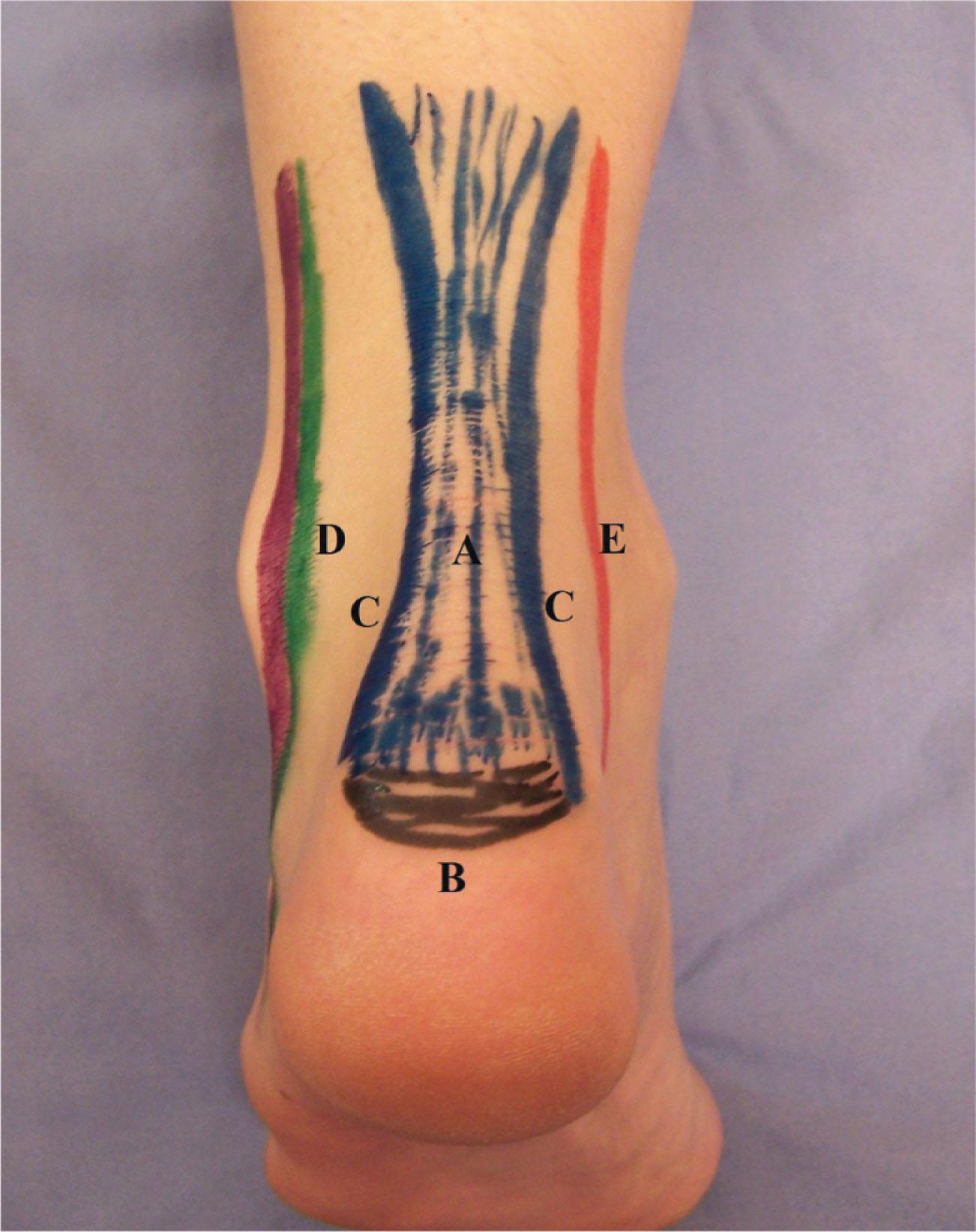
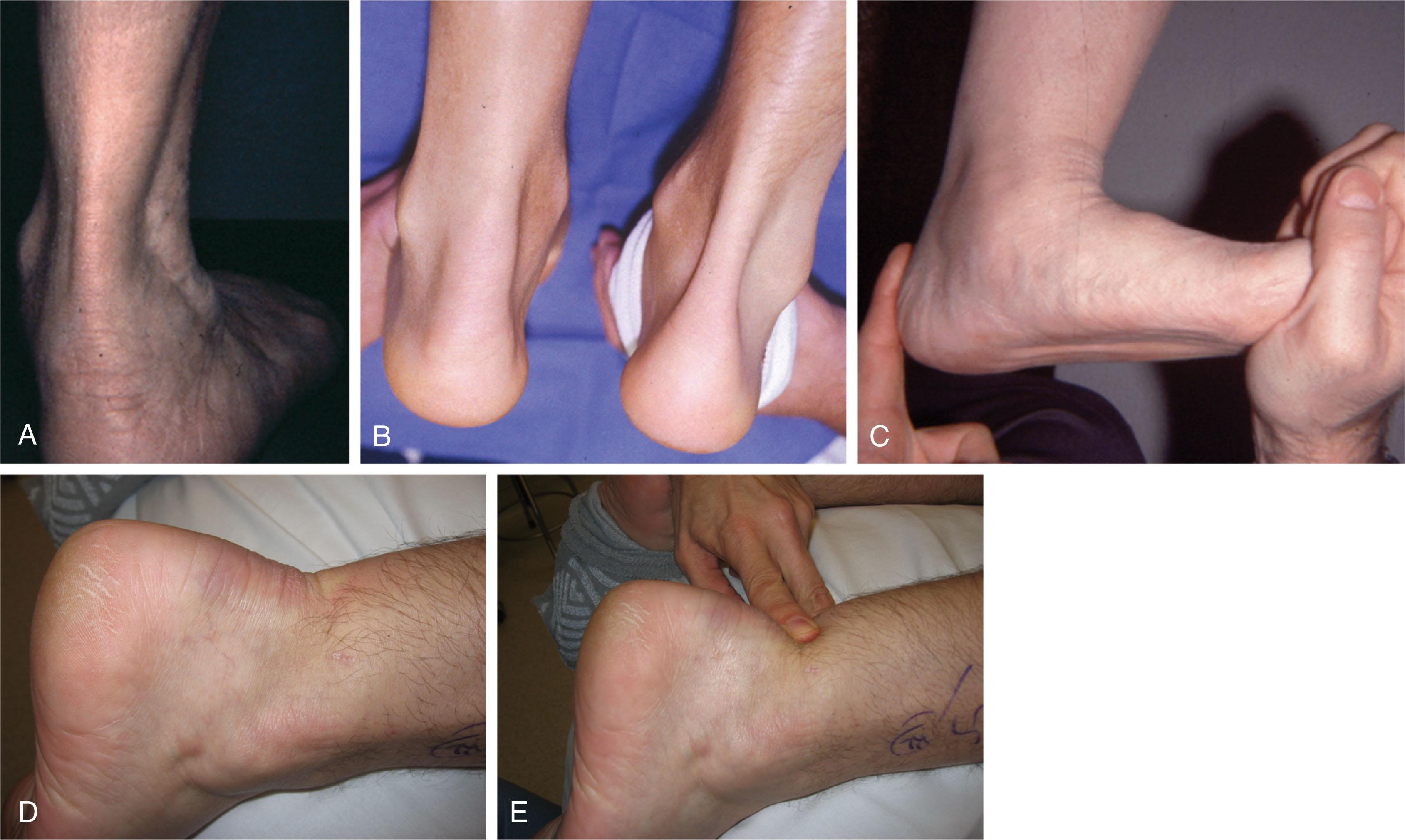
The anterior ankle ( Fig. 2-10 ) is defined by the readily palpable anterior tibialis tendon (A) . The tendon is found by asking the patient to actively dorsiflex the ankle. The anterior tibialis, first felt at or near the midanterior ankle just proximal to the malleoli, is the largest tendon structure that passes more medially as it travels distally. Its insertion on the plantar medial cuneiform and plantar first metatarsal is defined with the same dorsiflexion maneuver as well as inversion ( Fig. 2-11 ).
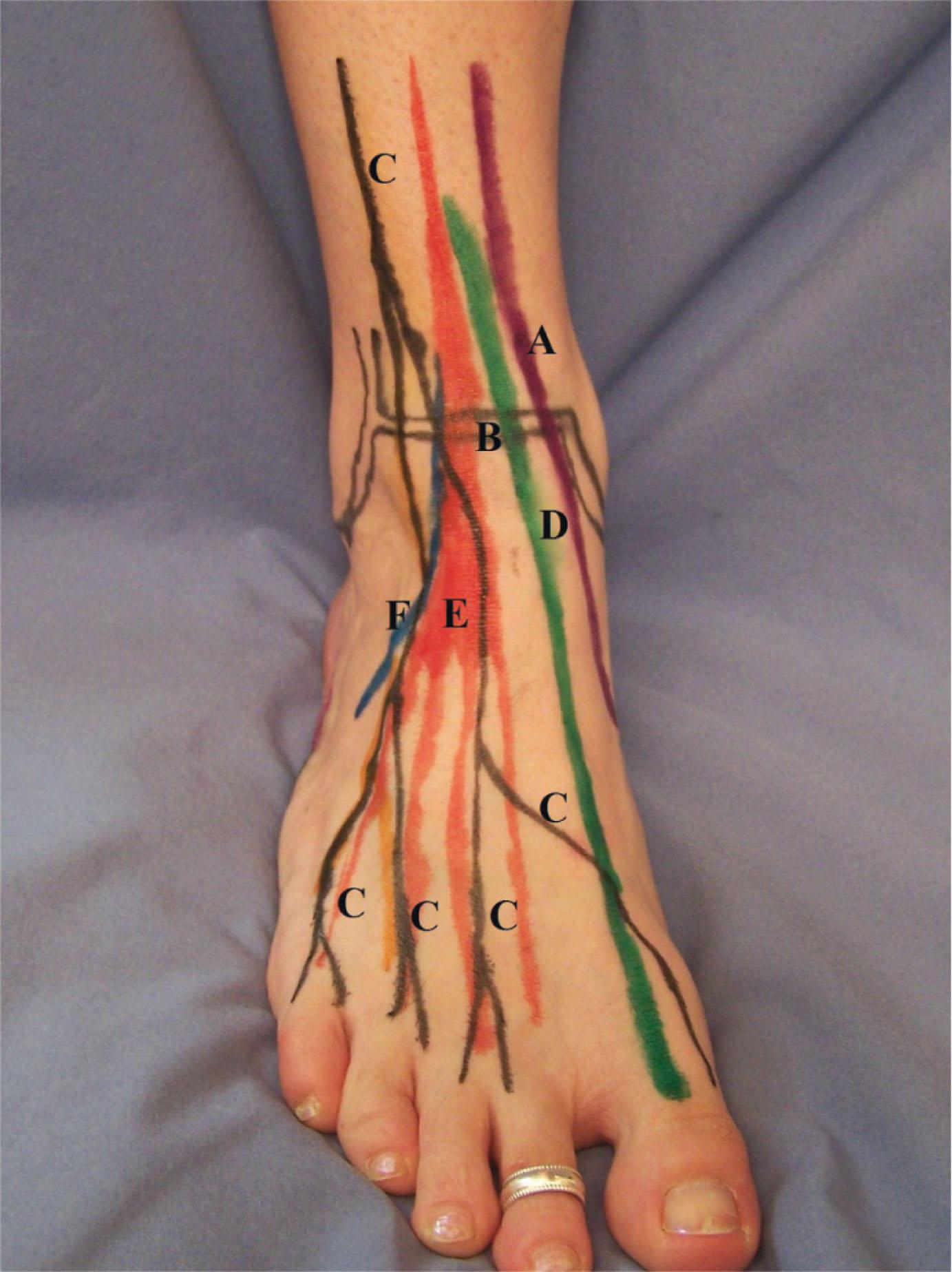
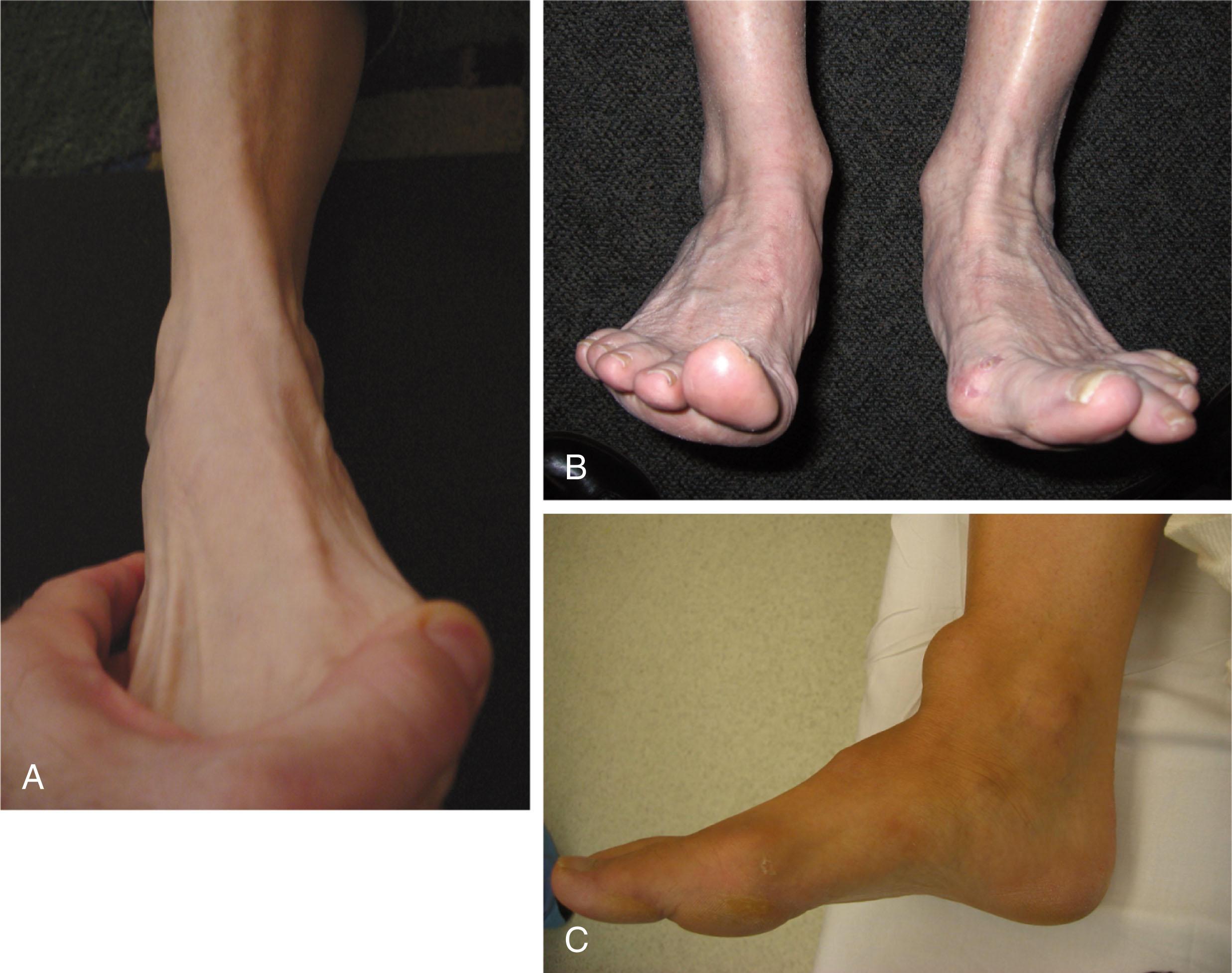
On either side of the anterior tibialis tendon, the anterior ankle joint (B) can be felt by deep palpation. The distinction between the tibia and the talus is more easily felt with gentle dorsiflexion and plantar flexion of the ankle joint. The transition from anterior tibia to anterior fibula is quite superficial and can help guide the estimation of the location of the less superficial midanterior tibia and talus. The branches of the superficial peroneal nerve (C) are palpated by gently rolling the fingers over the superficial portions of the anterior ankle ( Fig. 2-12 ). All of these branches are found lateral to the anterior tibialis. The pulse of the dorsalis pedis artery is usually felt not at the ankle but in the dorsal midfoot.
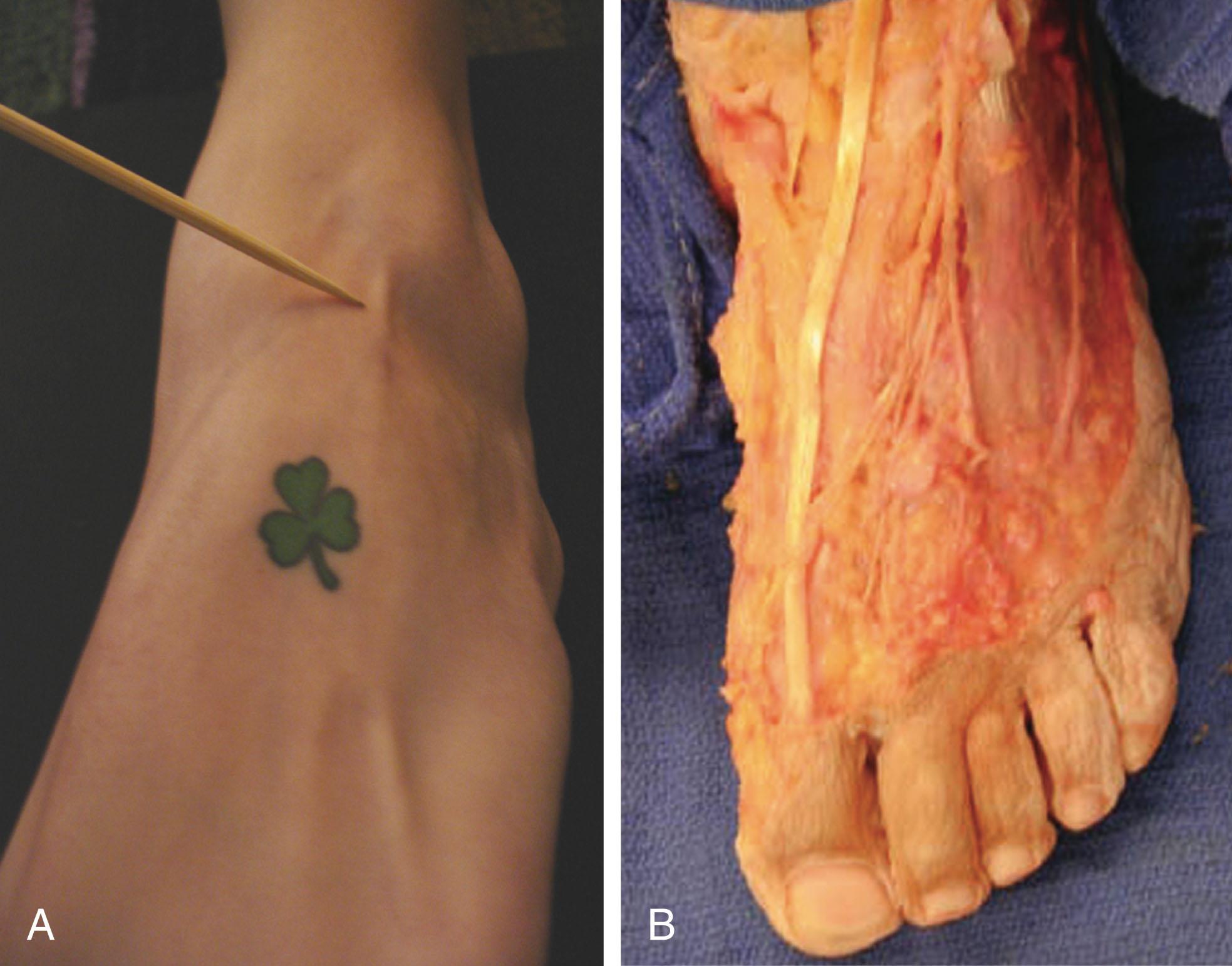
The remaining tendons of the anterior ankle (see Fig. 2-10 ) are all found lateral to the anterior tibialis. From medial to lateral, these easily palpable tendons are the extensor hallucis longus (EHL) (D) , the extensor digitorum longus (EDL) (E) , and the peroneus tertius (F) (found in most people). The examination of these tendons can be made easier by active dorsiflexion or passive plantar flexion of the toes and ankle.
Examination of the plantar-lateral aspect of the hindfoot begins with defining the anatomy of the lateral calcaneal area ( Fig. 2-13 ). If the examiner palpates the posterior most aspect of the calcaneus and runs a finger distal to it, the lateral edge of the calcaneus can be felt as separate from the lateral aspect of the plantar fat pad. The fat pad begins to be prominent at the glabrous skin junction. On the plantar surface, the lateral band of the plantar fascia (PF) and the abductor digiti minimi (A) are most often indistinguishable as a pinchable band originating from the palpable lateral calcaneus and extending distal to the fifth metatarsal head. The sural nerve may be felt as a cord just plantar to the peroneal tendons as they run along the calcaneal wall, though it is often not easily palpable.
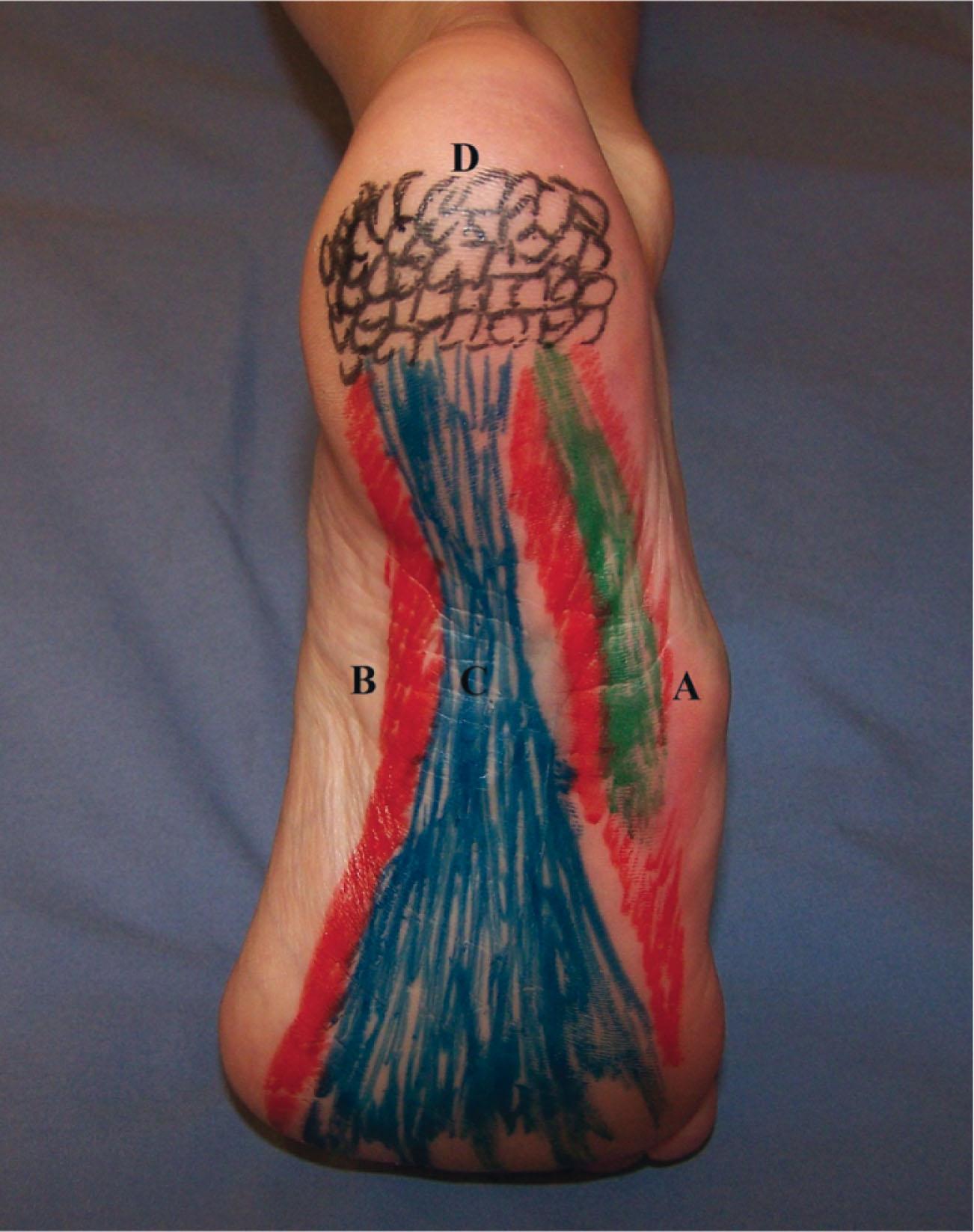
The plantar-medial hindfoot is best located from the posterior calcaneus by running a finger along the plantar-medial border of the bone. Soon, the bone becomes less subcuticular as the soft tissues of the arch are more prominent. The abductor hallucis muscle (B) can be palpated as it originates from the plantar-medial calcaneus and extends distally to insert on the plantar-medial first metatarsophalangeal (MTP) joint. The medial cord of the PF (C) is palpated just plantar and lateral to the abductor hallucis. It is felt most readily by passively dorsiflexing the toes.
The origin of the medial cord of the PF is best felt by passively dorsiflexing the toes and then running a thumb posterior until it is felt on the proximal plantar calcaneus. Deep palpation is required, as the examiner feels posteriorly, because the thick plantar fat pad (D) covers this area by covering the posterior-plantar calcaneus ( Fig. 2-14 ). The heel pad is thinner as the plantar hindfoot transitions to the non–weight-bearing arch. There are no palpable neural or vascular structures in the plantar hindfoot, but the medial and lateral plantar nerves are just deep to the abductor hallucis muscle as they cross into the plantar hindfoot. Deep palpation can elicit tenderness in the respective distributions of these nerves.
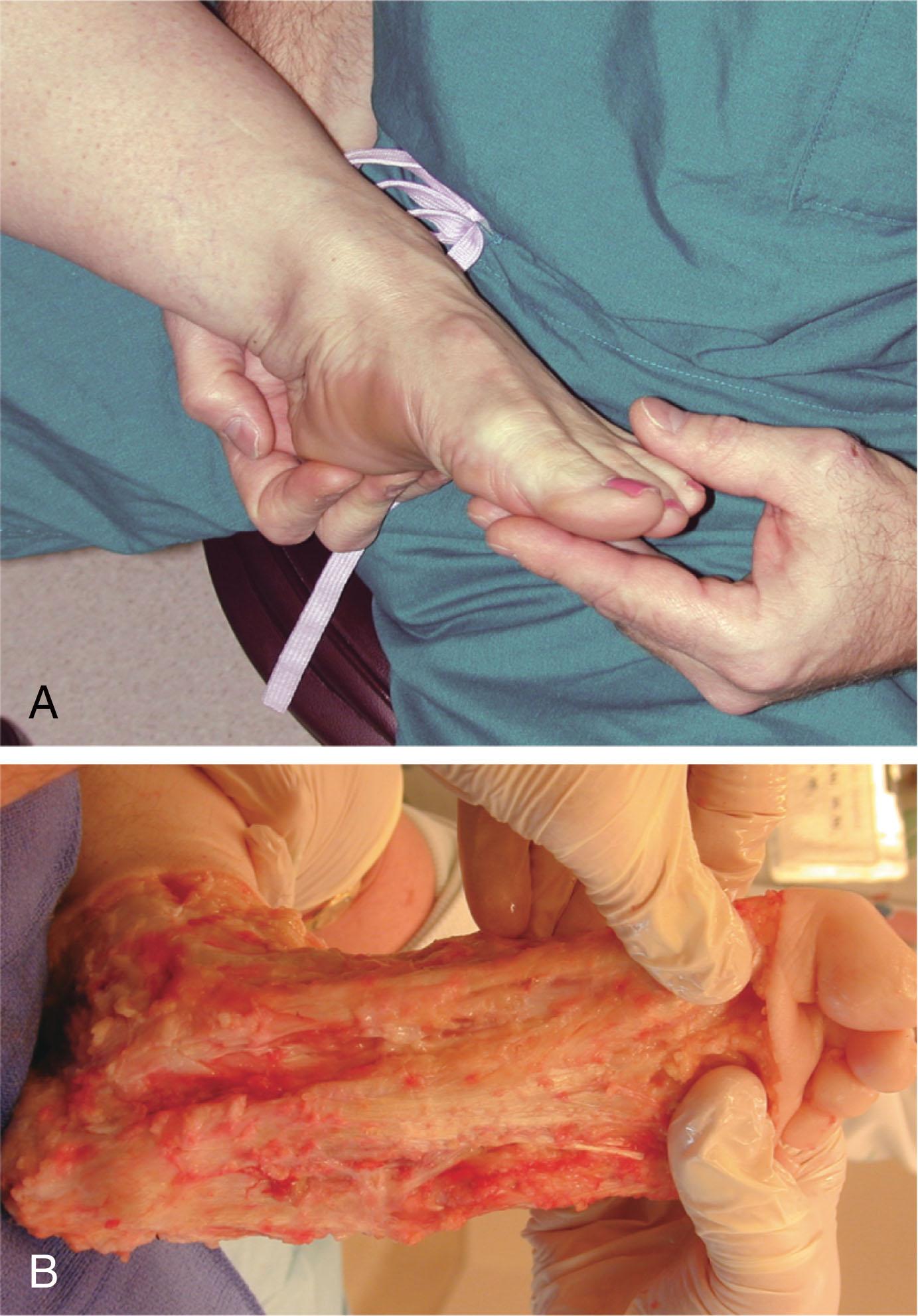
The structures of the dorsal midfoot, in most cases, can be appreciated with a careful examination ( Fig. 2-15A and B ). The bones of the midfoot can all be palpated most readily on the dorsum. The osteology of the dorsal midfoot is best felt by starting proximal at the talonavicular joint (A) . The detail of the bony edges can be defined by the palpable joints. The talonavicular joint can be felt as the most mobile joint on the medial side. By moving the foot into abduction and supination, the mobility of the joint can be felt. Whereas some motion is present in the more distal joints, in the normal foot, the talonavicular joint is most mobile.
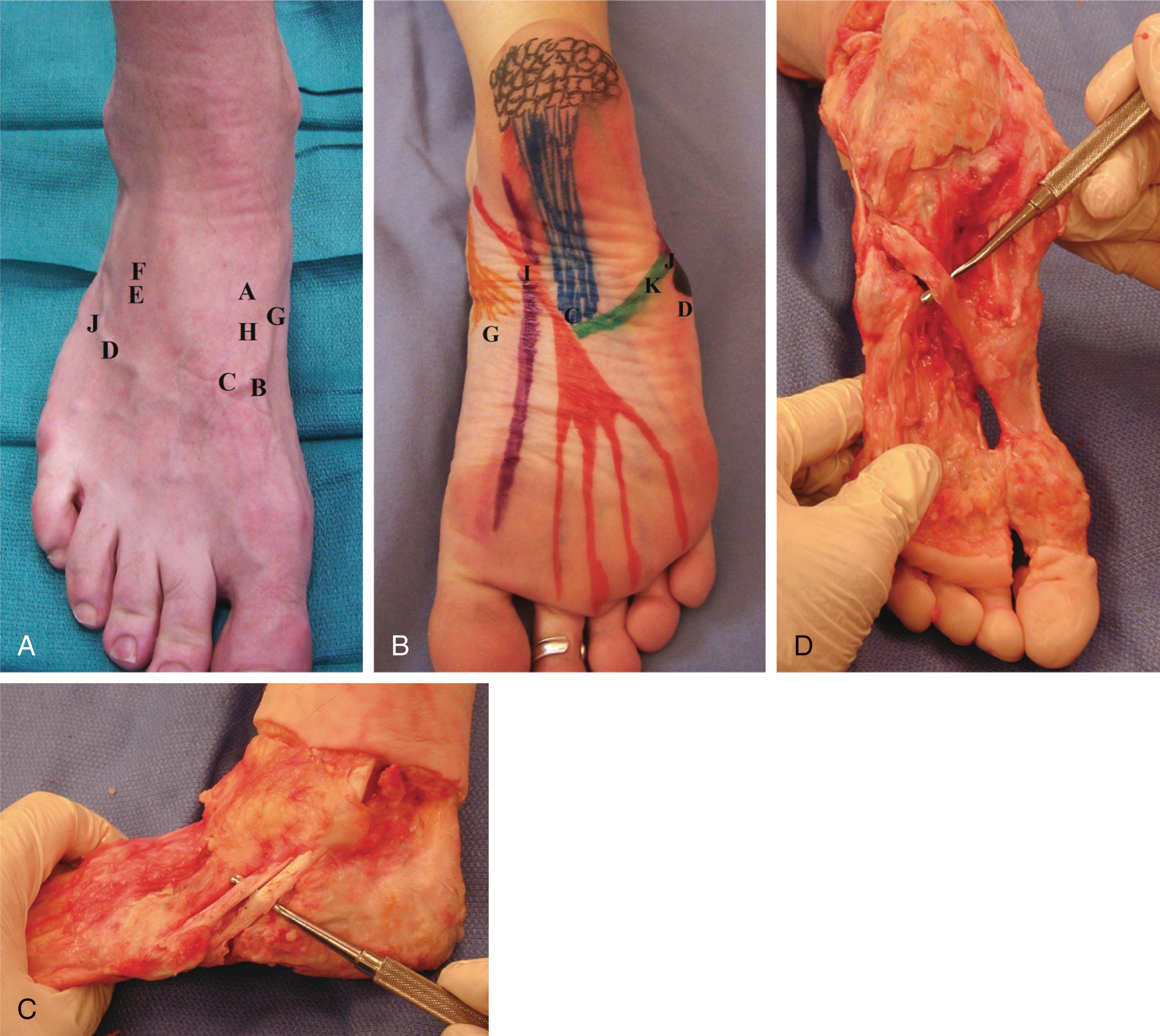
Once the talonavicular joint is found medially, the dorsal joint can be felt by running a finger along the navicular. Palpating distally while staying dorsal, the examiner will feel a subtle ridge or thickening at the navicular cuneiform joint and the first tarsometatarsal joint (B) . The edges of the joints can be followed to define the bony architecture of the corresponding bones. The bases of the lesser tarsometatarsal joints are best isolated by following the lesser metatarsal shafts from distal to proximal and in general are found more lateral in the midfoot than their respective toe in the forefoot on inspection. The second base is proximal to the first base, inset between the first and the third (C) .
The lateral aspect of the midfoot is more mobile than the medial and is best referenced from the prominent base of the fifth metatarsal (D) . This is the most lateral bony area on the lateral midfoot. It is both prominent and mobile. The calcaneocuboid joint (E) is isolated by holding the hindfoot stable and then dorsiflexing and plantar flexing the midfoot. The calcaneocuboid joint is the mobile segment just proximal to the base of the fifth metatarsal as the examiner feels along the lateral calcaneal wall. The anterior process of the calcaneus (F) is found by running a finger dorsally on the calcaneocuboid joint. The most dorsal palpable bony structure on this line is the anterior process of the calcaneus. It is also easily palpated as the bony prominence just anterior to the sinus tarsi. The fourth and fifth tarsometatarsal joint can be located by the same dorsiflexion and plantar flexion used for the calcaneocuboid joint, but the fifth joint is at the base of the fifth metatarsal and the fourth joint is slightly medial and dorsal to the fifth metatarsal.
The midfoot represents the insertion area of many of the ankle tendons. The medial midfoot is the insertion area for the posterior tibialis, the anterior tibialis, and the peroneus longus tendons. The insertion of the posterior tibialis (G) is best felt at the navicular tuberosity. When a patient actively supinates and inverts the foot, the tendon can be isolated proximally at the medial malleolus and followed to its insertion. The same can be done for the anterior tibialis (H) as it inserts on the plantar-medial aspect of the cuneiform and plantar proximal first metatarsal.
The insertion of the peroneus longus cannot be palpated specifically except in very thin patients, but its insertion on the plantar base of the first metatarsal is an area that can be mobile with peroneus longus activity. Asking the patient to actively plantar flex the first metatarsal can isolate the peroneus longus tendon (see Fig. 2-15C and D ).
The medial midfoot is an area where the examiner can palpate extrinsic tendons that insert distal in the forefoot. Directly plantar to the medial cuneiform ( Fig. 2-16 ), the point where the FHL and FDL cross (see Fig. 2-15 ), the master knot of Henry (I) can be located by deep palpation. This is made easier by active plantar flexion of the five toes. The medial cord of the PF covers the knot, but the moving tendons can be felt deep and medial to the medial cord of the static fascia. The EHL and EDL cross the dorsal medial midfoot and also are best palpated after active dorsiflexion of the toes.
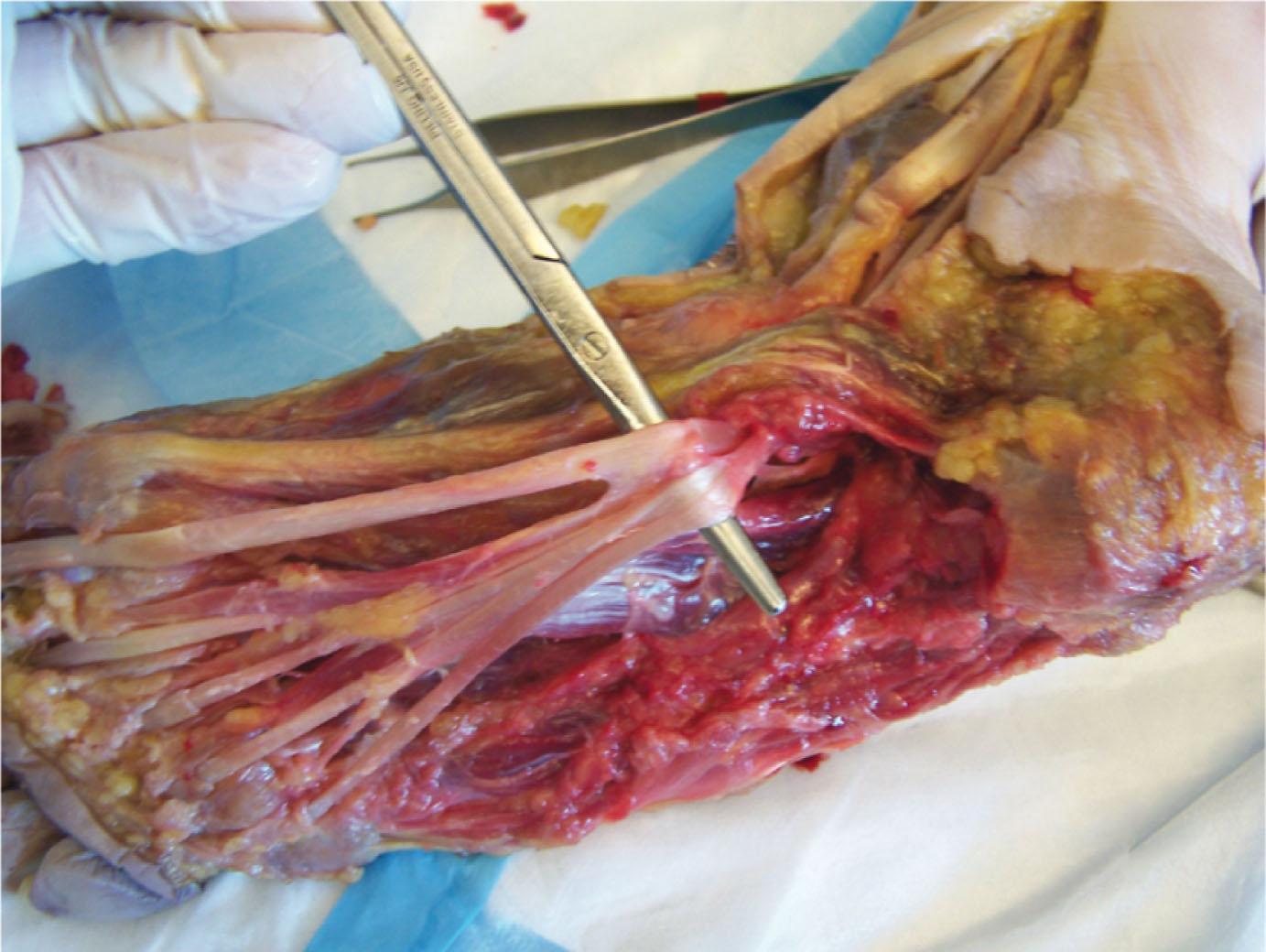
On the lateral side, the peroneus brevis insertion (J) on the base of the fifth metatarsal is best appreciated with active eversion. The peroneus longus can be palpated as it exits the inferior peroneal retinaculum plantar to the peroneus brevis. As the peroneus longus crosses superficial to the calcaneocuboid joint, it is felt as it dives plantar to head into the cuboid tunnel (K) and then across the bottom of the foot to the base of the first metatarsal. The cuboid tunnel and the peroneus longus in it can be palpated by deep pressure at the plantar-lateral cuboid.
The PF can be appreciated on the plantar midfoot with passive dorsiflexion of the toes (the Windlass mechanism). At the midfoot, the PF is wider than and not as thick as it is in the hindfoot. At this point, the examiner also can see the PF inserting to the five toes. The intrinsic foot muscles can be palpated as a group, but, other than the abductor hallucis (medial) and abductor digiti minimi (lateral), the specific muscles cannot be isolated.
Become a Clinical Tree membership for Full access and enjoy Unlimited articles
If you are a member. Log in here